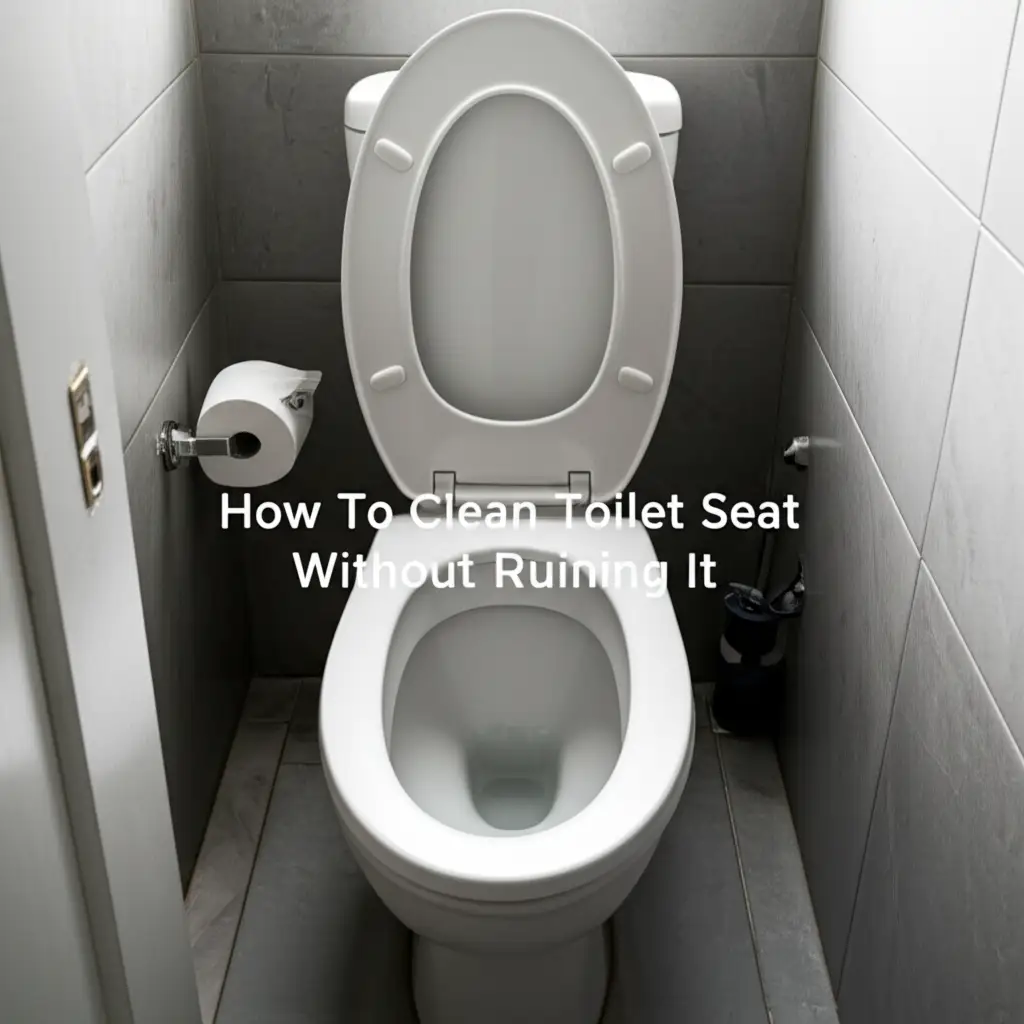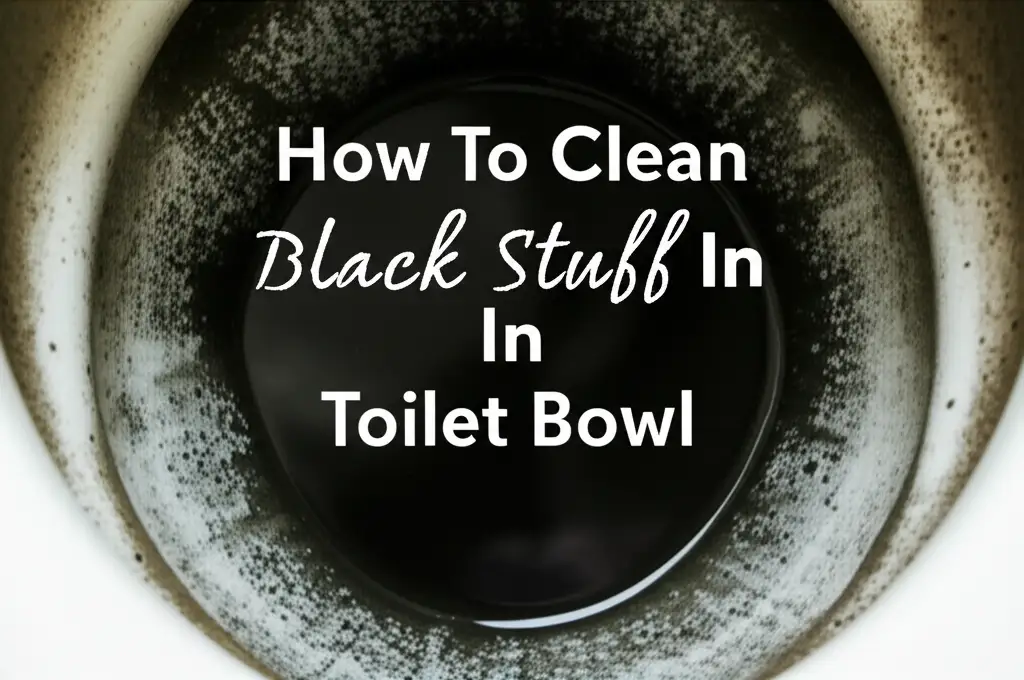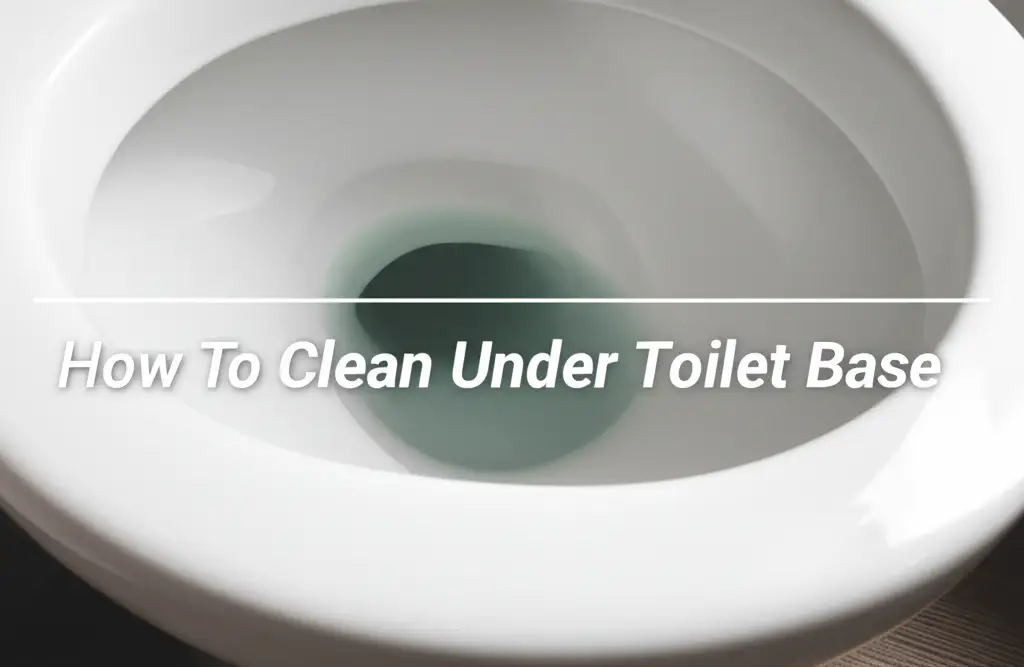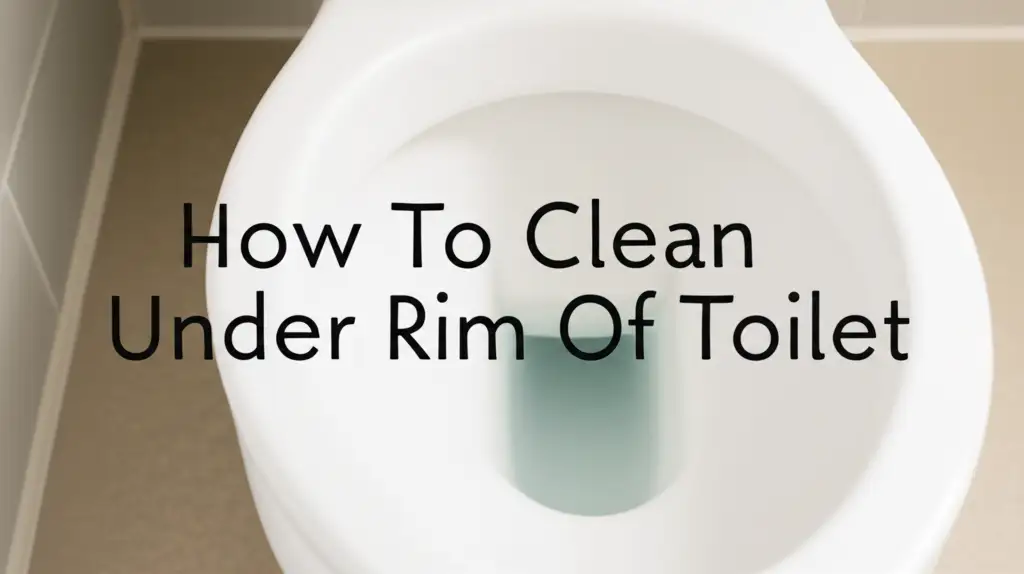· Bathroom Cleaning · 20 min read
How To Clean Toilet Seat Without Ruining It

How to Clean Toilet Seat Without Ruining It: The Gentle Guide
A clean bathroom feels fresh and inviting. Your toilet seat, a high-touch surface, needs regular cleaning. Many people worry about damaging the seat’s finish or material. I understand this concern; some cleaners can indeed cause harm. This guide shows you how to clean toilet seat without ruining it. I will share safe and effective methods. We will cover various seat materials and tackle common cleaning challenges.
Keeping your toilet seat clean means good hygiene for your home. It stops germs from spreading. It also helps your bathroom look its best. This article provides clear steps to clean and protect your toilet seat. You will learn about the right tools and products. You will also discover how to handle tough stains. By the end, you will feel confident cleaning your toilet seat gently and effectively.
Takeaway
- Identify Material: Know your toilet seat’s material to pick safe cleaners.
- Use Mild Cleaners: Stick to gentle, non-abrasive products for daily cleaning.
- Avoid Harsh Chemicals: Do not use abrasive scrubbers or strong chemical cleaners.
- Clean Regularly: Wipe down your seat often to prevent dirt buildup.
- Address Stains Early: Tackle discoloration and stains quickly with targeted methods.
- Dry Completely: Always dry the seat after cleaning to avoid water marks and mildew.
To clean a toilet seat without ruining it, use mild, non-abrasive cleaners like dish soap and water or diluted white vinegar. Always test new products on a small, hidden area first. Wipe the seat gently with a soft cloth and dry it completely after cleaning. This protects the material and prevents damage.
Understanding Your Toilet Seat Material
The material of your toilet seat dictates the best cleaning approach. Different materials react differently to cleaners. Knowing what your seat is made of helps you choose safe products. This step is key to avoiding damage.
Most toilet seats are made from durable materials. Plastic, enameled wood, and solid wood are common. Each type has its own care needs. Using the wrong cleaner can cause discoloration or surface damage. I always check the material first.
Plastic and Enameled Wood Seats
Plastic and enameled wood seats are very common. They are usually quite durable. These seats have a smooth, non-porous surface. This makes them easy to clean and maintain.
I often find these seats in most homes. They resist water well. You can use many common household cleaners on them. Still, some precautions are necessary.
- Mild Soaps: Dish soap and warm water work well.
- Diluted Bleach: A diluted bleach solution (1 part bleach to 10 parts water) can disinfect. Use it sparingly.
- All-Purpose Cleaners: Most gentle all-purpose cleaners are fine. Check labels for specific warnings.
- Avoid Abrasives: Do not use abrasive powders or scrubbing pads. They can scratch the surface.
Real Wood Seats
Real wood toilet seats offer a warm, classic look. They need different care than plastic seats. Wood is porous and can absorb liquids. It can also dry out or crack.
Proper cleaning keeps wood seats looking good. You need to be extra careful with these. Strong chemicals can strip the finish. Water can also cause damage if left too long.
- Gentle Soap: Use very mild soap, like a small amount of wood cleaner or gentle dish soap.
- Damp Cloth: Wipe with a damp (not wet) cloth.
- Dry Immediately: Always dry the wood seat completely after cleaning. This prevents water damage.
- Wood Polish: Apply a wood polish occasionally. This protects the finish and prevents drying.
Soft-Close and Specialized Seats
Many modern toilet seats have soft-close hinges. These hinges contain small mechanisms. They need gentle handling during cleaning. Getting water or harsh cleaners inside them can cause problems.
Some seats also have features like quick-release for easy cleaning. Understand how these work before you start. Special features need special attention.
- Hinge Care: Wipe hinges with a damp cloth. Do not soak them.
- Avoid Sprays: Do not spray cleaners directly onto the hinges. Spray the cleaner onto a cloth first.
- Manufacturer Instructions: Always check the manufacturer’s cleaning recommendations. This prevents damage to unique features.
Essential Cleaning Supplies You’ll Need
Having the right supplies makes cleaning easier and safer. You do not need a lot of special tools. Basic household items work well for most toilet seat cleaning. I always gather my supplies before I start. This saves time and ensures I have everything handy.
Choosing the correct cleaning products is important. Some products are too harsh. They can strip finishes or cause discoloration. My goal is to clean effectively without causing harm.
Safe Cleaning Solutions
The best cleaning solutions are mild. They lift dirt and kill germs without damaging materials. I often use simple, common products. They are safe for most toilet seat types.
- Dish Soap: A few drops of mild dish soap mixed with warm water creates a great general cleaner. It cuts through grime. It is gentle on surfaces.
- White Vinegar: Distilled white vinegar is a natural disinfectant and deodorizer. Mix equal parts vinegar and water in a spray bottle. This works well for light cleaning and removing mineral deposits. You can learn more about using how to clean with vinegar and baking soda for various cleaning tasks.
- Baking Soda: Baking soda is a gentle abrasive and deodorizer. Make a paste with a little water for tough spots. It can help lift stains without scratching. It is also good for general toilet hygiene, similar to how it’s used to clean toilet tank with baking soda.
- Hydrogen Peroxide: A 3% hydrogen peroxide solution can disinfect. It is a good bleach alternative for some surfaces. Use it directly on a cloth.
- Mild All-Purpose Cleaners: Many commercial all-purpose cleaners are fine. Look for “non-abrasive” and “safe for most surfaces” on the label. Always test in an unseen area first.
Cleaning Tools
The right tools help apply cleaners gently. They also help remove dirt effectively. Avoid anything that could scratch the seat. My go-to tools are soft and absorbent.
- Soft Microfiber Cloths: These cloths are gentle on surfaces. They absorb well and leave no lint. I use at least two: one for applying cleaner and one for drying.
- Soft Sponge: A non-scratch sponge can help scrub gently. Make sure it does not have an abrasive side.
- Old Toothbrush: A clean, old toothbrush is perfect for tight spots. It can reach around hinges and under the seat.
- Spray Bottle: A spray bottle allows for even application of liquid cleaners. It also helps dilute concentrates correctly.
- Rubber Gloves: Protect your hands from cleaners and germs. I always wear gloves for bathroom cleaning.
Step-by-Step Guide to Daily & Weekly Cleaning
Regular cleaning stops dirt from building up. It keeps your toilet seat hygienic and looking new. I find that quick, consistent cleaning sessions work best. This approach prevents tough stains from forming. It also makes deep cleaning less frequent and easier.
Let me walk you through my routine. This method is gentle yet effective. It works for most standard toilet seats. It ensures you clean the seat without causing any damage.
Daily Wipe-Down for Freshness
A quick daily wipe-down maintains cleanliness. It removes immediate spills and general dust. This small effort makes a big difference in bathroom hygiene. It takes very little time.
- Prepare your Solution: Mix a few drops of mild dish soap with warm water in a small bowl. Alternatively, use your diluted white vinegar spray.
- Dampen a Cloth: Dip a soft microfiber cloth into the soap solution. Wring it out well. The cloth should be damp, not dripping.
- Wipe All Surfaces: Gently wipe the top and bottom of the toilet seat. Do not forget the lid. Pay attention to the edges and where the seat meets the bowl.
- Rinse and Dry: Use a second clean, damp cloth (with plain water) to wipe away any soap residue. Then, immediately dry the entire seat with a dry microfiber cloth. This prevents water spots and helps prevent mildew.
Weekly Deep Clean for Hygiene
A weekly clean targets more grime and germs. It goes deeper than the daily wipe. This ensures your toilet seat is truly sanitary. I dedicate a bit more time to this step.
- Lift the Seat and Lid: Raise both the toilet seat and the lid. This exposes the hinges and the top of the toilet bowl rim.
- Spray Cleaner: Spray your chosen mild cleaner (diluted vinegar, all-purpose cleaner, or mild soap solution) directly onto the seat. Let it sit for 1-2 minutes. This allows the cleaner to break down dirt. For tough stains, you might check out tips on how to clean toilet bowl stains without scrubbing, as some principles apply.
- Scrub Gently: Use a soft sponge or microfiber cloth. Gently scrub all surfaces of the seat, including the underside. Use an old toothbrush for the hinge areas.
- Clean Hinges and Bolts: Pay close attention to the hinges and mounting bolts. These spots can collect dirt and urine. Wipe them thoroughly.
- Rinse Thoroughly: Use a clean, damp cloth (dampened with plain water) to wipe away all cleaner residue. Rinse the cloth often.
- Dry Completely: Dry the entire seat, hinges, and bolts thoroughly with a dry cloth. Leaving water behind can lead to mildew or damage, especially on wooden seats.
Tackling Stubborn Stains and Discoloration
Sometimes, regular cleaning is not enough. Toilet seats can develop stubborn stains or yellowing. These issues need a bit more effort. My approach focuses on effective, yet safe, stain removal. I always aim to lift the stain without harming the seat’s finish.
Many stains come from hard water minerals, urine, or cleaning product residue. Discoloration, especially yellowing, often happens over time with plastic seats. Do not despair; there are ways to restore your seat’s appearance.
Removing Yellow Stains and Discoloration
Yellowing on plastic toilet seats is a common problem. It happens due to oxidation, urine stains, or sunlight exposure. Patience and the right cleaner are key. I avoid harsh abrasives, as they can worsen the problem.
- Baking Soda Paste: Mix baking soda with a little water to form a thick paste. Apply this paste generously over the yellowed areas. Let it sit for at least 30 minutes, or even a few hours for severe yellowing.
- Vinegar Soak: For stubborn yellowing, spray the area with white vinegar after applying the baking soda paste. The reaction between baking soda and vinegar can help lift the stain. This method is similar to how you can use vinegar and baking soda for cleaning in other areas.
- Hydrogen Peroxide: For deep yellowing, dampen a clean cloth with 3% hydrogen peroxide. Lay the cloth directly on the stained area. Cover it with plastic wrap to prevent evaporation. Let it sit for several hours or overnight. This method uses a gentle bleaching action.
- Gentle Scrub and Rinse: After soaking, gently scrub the area with a soft brush or non-abrasive sponge. Rinse thoroughly with clean water. Dry the seat completely.
Dealing with Hard Water Stains and Mineral Deposits
Hard water leaves mineral stains. These often appear as white, chalky, or brownish rings. They stick firmly to surfaces. Acidic cleaners work best on these deposits.
- White Vinegar Application: Soak paper towels in undiluted white vinegar. Lay these vinegar-soaked towels directly onto the hard water stains. Ensure good contact with the stains.
- Soak Time: Let the vinegar-soaked towels sit for several hours, or even overnight. The acid in the vinegar will break down the mineral deposits.
- Scrub and Rinse: After soaking, remove the paper towels. Gently scrub the softened stains with a non-abrasive sponge or an old toothbrush. You may see stubborn stains inside the toilet bowl itself, similar to how to clean black stuff in toilet bowl. Rinse the area with clean water.
- Repeat if Necessary: For very old or thick deposits, you might need to repeat the process. Follow up with a good drying.
General Stubborn Stains
For other stubborn spots, like residue from hair products or general grime, targeted action helps. I always try the mildest method first. Stronger options are a last resort.
- Rubbing Alcohol: For sticky residues or marker stains, dampen a cloth with rubbing alcohol. Gently rub the affected area. Alcohol evaporates quickly.
- Magic Eraser (Melamine Foam Sponge): These sponges can remove many marks. Use them gently with water only. Test on a hidden spot first. They act as a very fine abrasive. Be careful not to scrub too hard, as they can dull shiny finishes over time.
- Commercial Stain Removers: If natural methods fail, look for specific toilet seat stain removers. Read the labels carefully. Ensure they are safe for your seat material. Always test in an inconspicuous area.
Deep Cleaning and Disinfection Strategies
Deep cleaning goes beyond surface dirt. It targets unseen germs and bacteria. This step is vital for a truly hygienic bathroom. While daily cleaning keeps things tidy, deep cleaning ensures sanitation. I perform a deep clean regularly, especially for high-traffic bathrooms. This process uses stronger, yet safe, disinfectants.
The goal is to kill pathogens without damaging your toilet seat. Different disinfectants suit different needs and materials. Always follow product instructions for safety and effectiveness.
Choosing the Right Disinfectant
Selecting the correct disinfectant is important. Some common disinfectants work well without harshness. I prioritize products that are effective but gentle on surfaces.
- Diluted Bleach Solution: For plastic or enameled seats, a diluted bleach solution works. Mix 1 part bleach with 10 parts water. This is a very strong disinfectant. Apply it carefully to a cloth, not directly to the seat. Avoid using bleach on wooden seats.
- Hydrogen Peroxide: A 3% hydrogen peroxide solution is a good alternative. It kills most germs and is gentler than bleach. You can spray it directly onto the seat or apply with a cloth. Let it sit for several minutes before wiping.
- Disinfectant Sprays/Wipes: Many commercial disinfectant sprays or wipes are available. Look for those labeled as “bathroom cleaner” or “disinfectant.” Check the product label to ensure it is safe for your toilet seat’s material. Always follow the dwell time recommended by the manufacturer to ensure proper germ killing.
- Rubbing Alcohol (Isopropyl Alcohol): A solution of 70% isopropyl alcohol effectively disinfects. It evaporates quickly and leaves no residue. Spray it on a cloth and wipe down the seat. It is generally safe for most plastic surfaces.
Deep Cleaning Steps for Sanitation
Once you have chosen your disinfectant, the deep cleaning process is systematic. It ensures all areas are treated. I pay extra attention to hidden spots where germs can hide.
- Preliminary Cleaning: First, clean the toilet seat as you would for a weekly clean. Remove all visible dirt, grime, and soap scum. Disinfectants work best on already clean surfaces.
- Apply Disinfectant:
- For Liquid Solutions (Bleach, Peroxide, Sprays): Spray the solution onto a clean microfiber cloth. Do not spray directly onto hinges. Wipe down the entire toilet seat, including the top, bottom, and lid. Ensure good coverage.
- For Wipes: Use a disinfectant wipe to thoroughly clean all surfaces.
- Allow Dwell Time: Let the disinfectant sit on the surface for the recommended “dwell time.” This is the time the product needs to kill germs effectively. Check the product label; it is usually 5-10 minutes.
- Wipe and Rinse: After the dwell time, wipe down the seat with a clean, damp cloth. Remove any remaining disinfectant residue. For bleach solutions, thorough rinsing is especially important.
- Dry Completely: Use a separate dry microfiber cloth to thoroughly dry the entire toilet seat. Ensure no moisture remains, particularly around hinges and on wooden seats. This prevents water damage, streaking, and mildew growth.
- Don’t Forget the Bolts and Underside: These areas often get overlooked. Wipe around the mounting bolts and the underside of the seat thoroughly. Use an old toothbrush for hard-to-reach spots.
Special Considerations for Different Seat Types
Not all toilet seats are alike. As discussed earlier, materials vary. This means cleaning methods also need to adapt. Proper care prevents damage and extends the life of your seat. I always adjust my cleaning based on the specific seat I am working with. This ensures the best results without any harm.
Understanding these differences helps you make informed choices. It avoids common cleaning mistakes that can ruin a toilet seat. Your approach should always be gentle but effective.
Wooden Seats: Protection and Care
Wooden toilet seats add warmth and style. They require specific care. Wood can absorb moisture and harsh chemicals. This can lead to warping, cracking, or stripping the finish. My focus for wooden seats is always on gentle cleaning and protection.
- Avoid Excess Water: Never soak a wooden seat. Do not use very wet cloths. A damp cloth is enough for cleaning.
- Mild Soap Only: Use only very mild soap, such as a few drops of gentle dish soap in warm water. Avoid strong detergents or abrasive cleaners.
- Dry Immediately: This is the most crucial step for wooden seats. After wiping, dry the seat completely with a soft, dry cloth. Do not let water sit on the wood.
- Wood Conditioner/Polish: Apply a wood conditioner or polish every few months. This maintains the finish and prevents the wood from drying out. It also creates a protective barrier against moisture.
- No Bleach or Harsh Disinfectants: These chemicals can damage wood finishes. Stick to mild soap or very diluted hydrogen peroxide if disinfection is needed, and test first.
Soft-Close Hinges: Gentle Handling
Soft-close toilet seats have special hinges. These mechanisms allow the seat to close slowly and quietly. They are usually made of plastic or metal components. These hinges need gentle cleaning to avoid damage. Getting water or cleaner inside them can impair their function.
- Clean Around, Not Into: Clean the hinges by wiping around them. Avoid spraying cleaners directly onto the hinge mechanism.
- Spray onto Cloth: Instead, spray your cleaner onto a microfiber cloth. Then, use the damp cloth to wipe the hinges.
- Use a Toothbrush: An old, soft toothbrush can help clean tight spots around the hinges. Be gentle and do not force bristles into the mechanism.
- Dry Thoroughly: Ensure the hinges are completely dry after cleaning. Moisture can lead to rust on metal parts or disrupt the soft-close function.
- Check Manufacturer Guidelines: If you notice issues with the soft-close mechanism, refer to the seat’s manufacturer instructions. Some hinges can be removed for better cleaning.
Quick-Release Seats: Easy Maintenance
Many modern seats feature quick-release buttons or tabs. These allow you to easily unclip the seat from the toilet bowl. This is a fantastic feature for thorough cleaning. I highly recommend using it.
- Remove the Seat: Follow the manufacturer’s instructions to unclip and remove the seat. It usually involves pressing two buttons or lifting two tabs near the hinges.
- Clean Separately: Once removed, you can clean the seat more easily in a sink or bathtub. You can access all sides without awkward angles.
- Clean Mounting Posts: The area where the seat attaches to the bowl can get very dirty. Clean these mounting posts and the holes thoroughly.
- Reattach Correctly: After cleaning and drying both the seat and the mounting area, reattach the seat. Make sure it clicks securely back into place. This ensures stability and proper function.
Common Mistakes to Avoid When Cleaning Your Toilet Seat
Cleaning a toilet seat seems simple. However, some common mistakes can ruin its appearance or function. I have seen many good seats damaged by incorrect cleaning practices. Avoiding these pitfalls protects your investment. It also ensures your toilet seat stays hygienic and looks good for years.
My advice is to always prioritize gentleness and material compatibility. Harsh chemicals and abrasive tools are often the culprits. Learning what not to do is as important as knowing what to do.
Using Abrasive Cleaners or Tools
This is perhaps the biggest mistake. Abrasives cause irreversible damage. They scratch the surface of your toilet seat. These tiny scratches then trap dirt and germs. They also make the seat look dull and worn.
- Avoid Scouring Powders: These products contain fine abrasive particles. They are too harsh for smooth plastic or enameled surfaces.
- No Rough Sponges: Do not use the green, abrasive side of sponges. Steel wool pads are also a definite no.
- Steer Clear of Stiff Brushes: Hard-bristled brushes can scratch. Stick to soft brushes or microfiber cloths.
Applying Harsh Chemicals Undiluted
Strong chemicals like undiluted bleach, toilet bowl cleaner, or oven cleaner are too aggressive for most toilet seat materials. They can cause chemical burns, discoloration, or even degrade the plastic or finish over time.
- Always Dilute: If using bleach, always dilute it significantly (1 part bleach to 10 parts water).
- Read Labels: Check the “safe for” section on cleaning product labels. Do not assume a product is safe for toilet seats just because it is a “bathroom cleaner.”
- Test in an Inconspicuous Area: Before using a new cleaner, test it on a small, hidden spot, like the underside of the seat, near a hinge. Wait a few minutes to see if there is any adverse reaction.
Forgetting to Dry the Seat Properly
Leaving the toilet seat wet after cleaning causes problems. Water contains minerals that can leave spots. More importantly, prolonged moisture can lead to mildew growth, especially in damp bathrooms. For wooden seats, it can cause warping or cracking.
- Always Dry: After rinsing, always use a separate, dry cloth to wipe the entire seat dry.
- Pay Attention to Crevices: Water can pool around hinges and under the seat. Ensure these areas are also completely dry.
Neglecting Hinges and Mounting Areas
Hinges and the mounting bolts often get overlooked. These areas collect dust, grime, and splashes. They can become a breeding ground for bacteria. Dirty hinges can also look unsightly and even smell.
- Regular Cleaning: Include hinges and mounting areas in your weekly cleaning routine.
- Use a Toothbrush: An old toothbrush is excellent for getting into these tight spots.
- Lift the Seat: If possible, remove the quick-release seat or lift it to clean underneath the mounting points thoroughly.
Overlooking Manufacturer Guidelines
Different toilet seat brands and materials may have specific care instructions. Ignoring these guidelines can lead to unintended damage. For example, some specialized finishes might be sensitive to certain common cleaners.
- Check Manuals: If you still have the toilet seat’s manual, review its cleaning recommendations.
- Online Search: If not, search online for the manufacturer’s cleaning advice for your specific model.
FAQ Section
Q1: How do I remove yellow stains from a plastic toilet seat? A1: For yellow stains, make a paste of baking soda and water. Apply it to the stain and let it sit for 30 minutes to a few hours. You can also spray vinegar on top for extra power. For very stubborn yellowing, lay a cloth soaked in 3% hydrogen peroxide over the stain, cover with plastic wrap, and leave overnight before scrubbing and rinsing.
Q2: Can I use bleach on a toilet seat? A2: You can use a highly diluted bleach solution (1 part bleach to 10 parts water) on plastic or enameled toilet seats for disinfection. Apply it with a cloth, not directly. Do not use bleach on wooden toilet seats, as it can damage the finish. Always rinse thoroughly and dry completely after using bleach.
Q3: What cleaners should I avoid on toilet seats? A3: Avoid abrasive cleaners like scouring powders, steel wool, or rough sponges. Do not use undiluted strong chemicals such as toilet bowl cleaner, oven cleaner, or concentrated bleach. These can scratch, discolor, or chemically damage the seat’s surface, especially on plastic or wooden materials.
Q4: How often should I clean my toilet seat? A4: Perform a quick wipe-down daily to remove surface dirt and spills. Conduct a more thorough deep clean, including disinfection, at least once a week. In high-traffic bathrooms or homes with illness, increase the frequency of deep cleaning for better hygiene.
Q5: Is baking soda safe for all toilet seat materials? A5: Yes, baking soda is generally safe for all toilet seat materials, including plastic, enameled wood, and real wood. It acts as a gentle abrasive and deodorizer. You can use it as a paste with water to clean stains or absorb odors without causing damage.
Q6: How do I clean soft-close toilet seat hinges? A6: Clean soft-close hinges gently. Avoid spraying cleaners directly onto the hinge mechanism. Instead, spray your cleaner onto a soft cloth and then wipe the hinges. Use an old toothbrush for tight spots. Always dry the hinges completely after cleaning to prevent rust or damage to the mechanism.
Conclusion
Keeping your toilet seat clean is a simple yet essential part of bathroom hygiene. By choosing the right products and methods, you can clean toilet seat without ruining it. Remember to always consider the material of your seat. Plastic, wood, and specialized hinges all need specific, gentle care. My goal is to make your cleaning routine effective and worry-free.
Using mild soaps, white vinegar, or baking soda often provides the best results. These simple ingredients tackle most dirt and stains safely. Always avoid harsh chemicals and abrasive scrubbers. A little attention to detail, like drying the seat completely, goes a long way. With
- toilet seat cleaning
- bathroom hygiene
- gentle cleaning
- stain removal
- disinfectant
- cleaning tips




